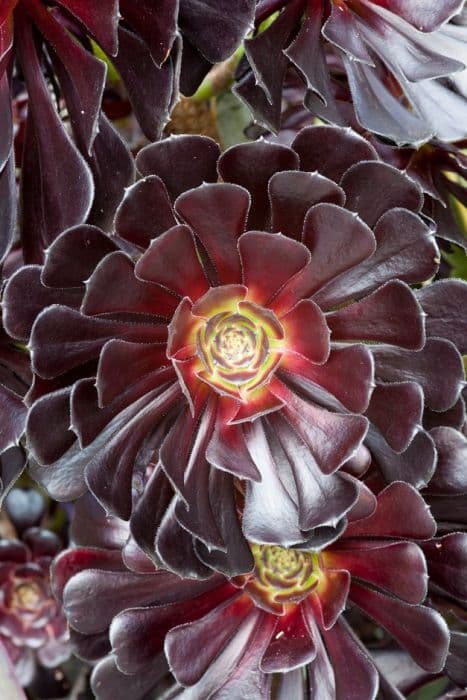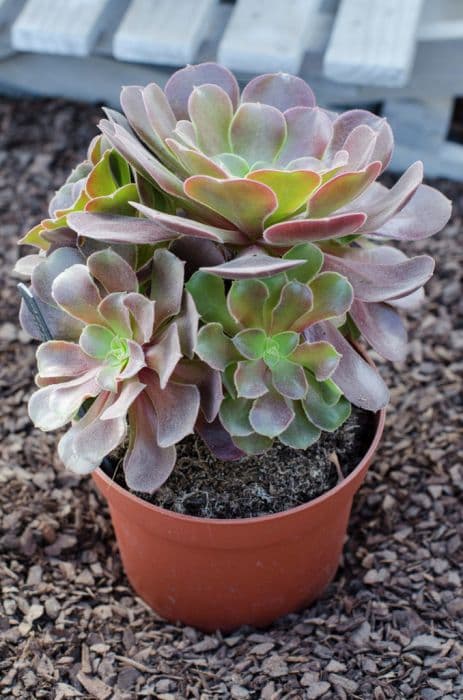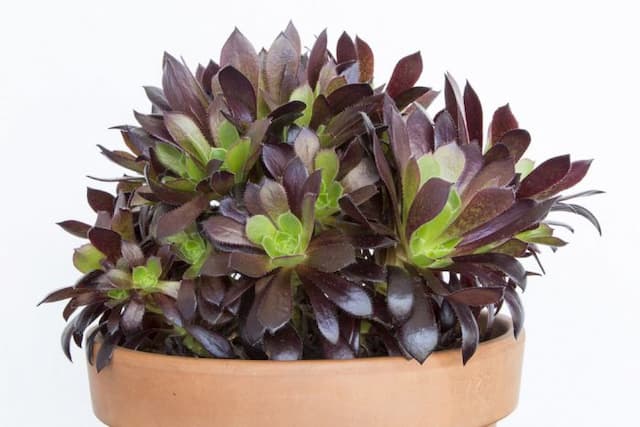Tricolor Aeonium Aeonium haworthii 'Variegatum' (v)

ABOUT
The Aeonium haworthii 'Variegatum', also known as the variegated aeonium, has a unique and picturesque appearance that makes it popular among succulent enthusiasts. The leaves are its most striking feature, which are arranged in a rosette pattern. Each leaf is fleshy and spoon-shaped, displaying a beautiful array of colors. The variegation in the leaves presents as creamy white and green stripes, which can sometimes take on a pink hue when exposed to enough sunlight, giving the edges a delicate blush. This variegation not only adds visual interest but also means that no two leaves are exactly alike, making each rosette a one-of-a-kind display. The plant has a branching habit, with multiple rosettes growing at the ends of its stems. These stems, which support the rosettes, are often woody in appearance and a muted green or brownish color, which contrasts nicely with the brightly colored leaves. As a succulent, the plant has thick leaves that store water, making them look plump and giving the plant a substantial, textural feel. The variegated aeonium's overall appearance is compact and symmetrical, which lends itself well to being a striking specimen in container gardens, rockeries, or as part of a succulent display. It exudes a sense of hardiness yet maintains a delicate charm because of the patterned foliage.
About this plant
 Names
NamesFamily
Crassulaceae.
Synonyms
Variegated Pinwheel, Tricolor Pinwheel, Variegated Aeonium, Variegatum.
Common names
Sempervivum haworthii 'Variegatum'
 Toxicity
ToxicityTo humans
Aeonium 'Kiwi' is generally considered non-toxic to humans. However, as with many plants, it is not intended for consumption, and eating the plant may cause mild stomach upset or discomfort. The sap may also cause minor skin irritation in sensitive individuals. There are no severe toxicity issues known for human ingestion of this plant.
To pets
Aeonium 'Kiwi' is also generally considered non-toxic to pets, such as cats and dogs. It should not pose a serious risk if ingested in small quantities. However, if a pet consumes large amounts of the plant, it may experience gastrointestinal upset, such as vomiting or diarrhea, just as with human ingestion. If any symptoms occur, it is recommended to consult with a veterinarian.
 Characteristics
CharacteristicsLife cycle
Perennials
Foliage type
Evergreen
Color of leaves
Variegated
Flower color
Yellow
Height
1-2 feet (0.3-0.6 meters)
Spread
1-2 feet (0.3-0.6 meters)
Plant type
Succulent
Hardiness zones
9
Native area
Canary Islands
Benefits
 General Benefits
General Benefits- Decorative Appeal: Aeonium haworthii 'Variegatum', commonly known as "pinwheel", has variegated leaves that add a unique visual interest to gardens, patios, or indoor spaces.
- Drought Tolerant: Being a succulent, the pinwheel is highly adapted to arid climates, requiring minimal watering and conserving water in its leaves.
- Low Maintenance: This plant requires little care beyond occasional watering, making it ideal for busy individuals or those with less gardening experience.
- Versatility: The pinwheel can be grown in containers, rock gardens, or as a groundcover, offering a range of landscaping options.
- Attracts Pollinators: Its blooms can attract insects like bees, which are beneficial for pollinating garden plants and flowers.
- Hardy: Pinwheel succulents can tolerate a wide range of conditions and are hardy in USDA zones 9-11, making them suitable for many outdoor environments.
- Propagation Ease: This plant can easily be propagated from cuttings, allowing gardeners to create new plants and expand their collections without additional cost.
 Medical Properties
Medical PropertiesThis plant is not used for medical purposes.
 Air-purifying Qualities
Air-purifying QualitiesThis plant is not specifically known for air purifying qualities.
 Other Uses
Other Uses- Aeonium haworthii 'Variegatum' can be used as a living mulch in garden beds, helping to retain soil moisture and suppress weeds with its dense foliage.
- In creative arts, this plant's attractive variegated patterns are sometimes replicated in paintings, textiles, and ceramic designs for aesthetic inspiration.
- The thick leaves can be used as a natural barrier or fence when planted in dense clusters, providing a distinct and decorative edge to garden paths.
- This succulent can be used in educational environments to teach children about plant propagation, as it easily propagates from cuttings.
- In mild climates, Aeonium haworthii 'Variegatum' can be grown as rooftop garden plants, aiding in building insulation and reducing heat absorption.
- The sculptural form of the plant makes it a favored subject for photography, particularly macro photography that highlights its rosette pattern and coloration.
- Aeonium haworthii 'Variegatum' can serve as a living ornament during festive seasons when potted and placed indoors due to its unique appearance.
- These plants are utilized in small, drought-tolerant landscape models to demonstrate sustainable gardening practices with little water requirement.
- The contrasting colors of the leaves provide a striking addition to floral arrangements and can be used as a preserved component in dried bouquets.
- As a non-toxic plant, it can be safely planted in pet-friendly gardens where animals might be inclined to nibble on greenery.
Interesting Facts
 Feng Shui
Feng ShuiThe Kiwi Aeonium is not used in Feng Shui practice.
 Zodiac Sign Compitability
Zodiac Sign CompitabilityThe Kiwi Aeonium is not used in astrology practice.
 Plant Symbolism
Plant Symbolism- Uniqueness: The variegated patterns of Aeonium haworthii 'Variegatum', also known as variegated pinwheel, signify uniqueness and celebrate diversity in nature and individuality in personal traits.
- Resilience: As a succulent, the variegated pinwheel represents resilience and the ability to thrive in challenging environments, drawing on inner strength to survive and flourish.
- Perpetuity: The rosette shape of the plant, which can look almost eternal, symbolizes continuity, cyclical progress, and the notion that life goes on.
- Adaptability: Aeonium haworthii 'Variegatum' is known for its ability to adapt to various light levels, symbolizing flexibility and the capacity to adjust to different situations in life.
 Water
WaterThe Pinwheel Aeonium requires watering every one to two weeks, allowing the soil to dry out completely between waterings. It is best to water deeply, providing around 8-16 ounces per plant each time you water, depending on the size of the pot. During the active growing season in spring and early summer, you may need to water more frequently, while in the winter, when the plant is dormant, watering can be reduced. Ensure proper drainage in the pot to prevent root rot.
 Light
LightThe Pinwheel Aeonium thrives in bright, indirect sunlight but can tolerate partial shade. The ideal spot for this plant would be a location where it can receive several hours of morning sun followed by light, dappled shade in the afternoon. Direct, hot afternoon sun might scorch the leaves, so it's best avoided.
 Temperature
TemperatureThe Pinwheel Aeonium prefers a temperature range between 40 and 80 degrees Fahrenheit. It can withstand brief periods outside of this range but should not be exposed to temperatures below freezing as it is not frost-hardy. The ideal temperature for promoting growth and health in this succulent is within the range of 65 to 75 degrees Fahrenheit.
 Pruning
PruningPruning Pinwheel Aeonium is mainly for aesthetic purposes and to remove any damaged or spent leaves. The best time to prune is in the spring, before the onset of the active growing season. It doesn't require frequent pruning; once per year is typically sufficient. Use clean, sharp scissors or pruning shears to avoid damaging the plant.
 Cleaning
CleaningAs needed
 Soil
SoilThe Kiwi Aeonium thrives in well-draining, sandy or gritty soil with a slightly acidic to neutral pH of about 6.0 to 7.5. A recipe for the best soil mix would be equal parts of potting soil, coarse sand, and perlite or pumice to ensure proper drainage.
 Repotting
RepottingKiwi Aeoniums should be repotted every two to three years or when they have outgrown their containers. Choose a pot that is slightly larger than the current one to give space for growth.
 Humidity & Misting
Humidity & MistingKiwi Aeonium prefers moderate humidity levels but is tolerant of dry air. It is adaptable to most indoor humidity conditions, making it a low-humidity tolerant plant.
 Suitable locations
Suitable locationsIndoor
Place in bright, indirect light and avoid overwatering.
Outdoor
Plant in sunny to part shade, well-draining area; protect from frost.
Hardiness zone
9-11 USDA
 Life cycle
Life cycleThe life cycle of Aeonium haworthii 'Variegatum', commonly known as variegated pinwheel, begins with seed germination, which occurs when conditions of moisture, temperature, and light are optimal. Seedlings emerge and establish a rosette of variegated leaves, which is a distinguishing characteristic of this succulent. This vegetative phase can last several years, during which the plant grows slowly, conserving resources and adapting to its environment. As it matures, the variegated pinwheel may produce offsets or "pups" around its base, a form of asexual reproduction that helps the plant spread. Once it reaches maturity, after several years, it develops a tall flowering stalk bearing clusters of small, star-shaped flowers, usually in summer. After flowering, the main rosette often dies, but the plant's lifecycle is continued through the offsets and new seeds it has produced.
 Propogation
PropogationPropogation time
Spring to Summer
Propogation: The Aeonium 'Kiwi', also known as Aeonium haworthii 'Variegatum' (v), is best propagated through cuttings. The ideal time for taking cuttings is during the plant's active growing period, which is typically spring or early summer. To propagate through cuttings, select a healthy, non-flowering stem and cut a piece that is about 2 to 4 inches long (5 to 10 cm). Allow the cutting to dry out for a few days until a callous forms over the cut surface. This helps prevent rotting when planted. Then, place the cutting in well-draining soil, watering it lightly until roots develop. Once the cutting has established roots, usually in a few weeks, you can begin to water it regularly.









